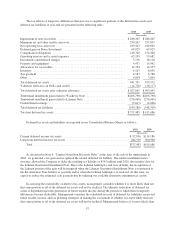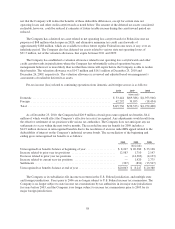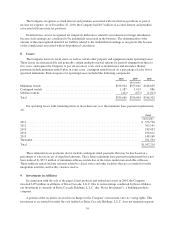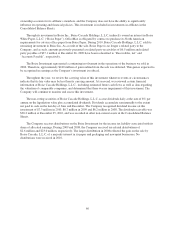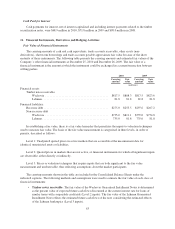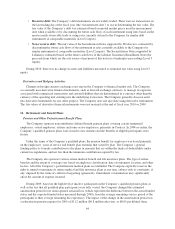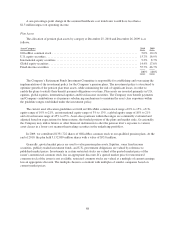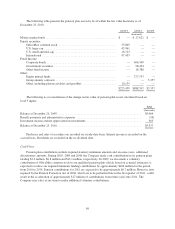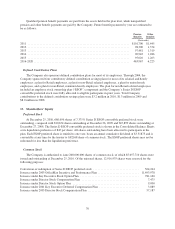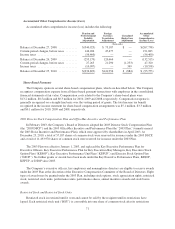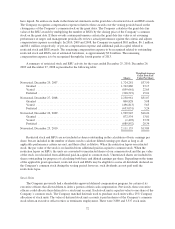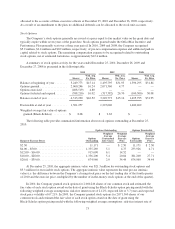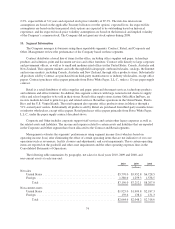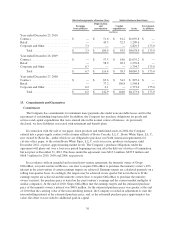OfficeMax 2010 Annual Report Download - page 87
Download and view the complete annual report
Please find page 87 of the 2010 OfficeMax annual report below. You can navigate through the pages in the report by either clicking on the pages listed below, or by using the keyword search tool below to find specific information within the annual report.
Assumptions
The assumptions used in accounting for the Company’s plans are estimates of factors including, among
other things, the amount and timing of future benefit payments. The following table presents the key weighted
average assumptions used in the measurement of the Company’s benefit obligations as of year-end:
Other Benefits
Pension Benefits United States Canada
2010 2009 2010 2009 2010 2009
Discount rate ................................ 5.64% 6.15% 4.50% 5.10% 5.30% 6.40%
The following table presents the weighted average assumptions used in the measurement of net periodic
benefit cost as of year-end:
Other Benefits
Pension Benefits United States Canada
2010 2009 2008 2010 2009 2008 2010 2009 2008
Discount rate ...................... 6.15% 6.20% 6.30% 5.10% 6.10% 5.90% 6.40% 7.30% 5.50%
Expected long-term return on plan
assets ........................... 8.20% 7.50% 8.00% ——————
In 2010 and 2009, the assumed discount rate (which is required to be the rate at which the projected benefit
obligation could be effectively settled as of the measurement date) is based on the rates of return for a theoretical
portfolio of high-grade corporate bonds (rated Aa1 or better) with cash flows that generally match our expected
benefit payments in future years. In selecting bonds for this theoretical portfolio, we focus on bonds that match
cash flows to benefit payments and limit our concentration of bonds by issuer. To the extent scheduled bond
proceeds exceed the estimated benefit payments in a given period, the yield calculation assumes those excess
proceeds are reinvested at an assumed forward rate. The implied forward rates used in the 2010 bond model are
based on the December 31, 2010 Citigroup Pension Discount Curve. In the 2009 bond model, the implied
forward rates used were based on the forecasted three-month Treasury bill rates. In 2008 and prior years, we
matched our expected future benefit payments to a hypothetical zero coupon discount curve derived from high
quality corporate bonds. The theoretical portfolio with matching cash flows is a more precise method for
developing a plan specific rate.
The expected long-term rate of return on plan assets assumption is based on the weighted average of
expected returns for the major asset classes in which the plans’ assets are held. Asset-class expected returns are
based on long-term historical returns, inflation expectations, forecasted gross domestic product and earnings
growth, as well as other economic factors. The weights assigned to each asset class are based on the Company’s
investment strategy. The weighted average expected return on plan assets used in the calculation of net periodic
pension benefit cost for 2011 is 8.2%.
Obligation and costs related to the Canadian retiree health plan are impacted by changes in trend rates.
The following table presents the assumed healthcare cost trend rates used in measuring the Company’s
postretirement benefit obligations at December 25, 2010 and December 26, 2009:
Canada
2010 2009
Weighted average assumptions as of year-end:
Healthcare cost trend rate assumed for next year ....................................... 7.0% 7.5%
Rate to which the cost trend rate is assumed to decline (the ultimate trend rate) .............. 5.0% 5.0%
Year that the rate reaches the ultimate trend rate ....................................... 2015 2015
67


